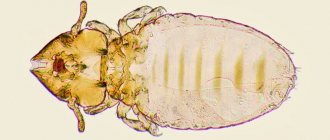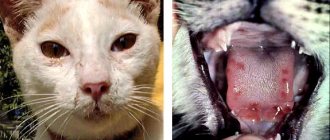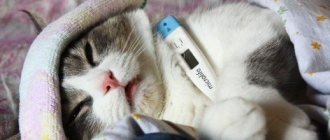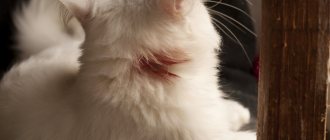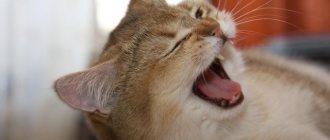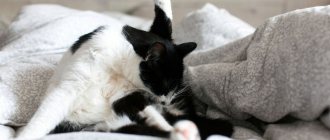Save the article:
Sometimes the owner, showing affection to his furry pet, notices that real dandruff has appeared in the cat’s fur. For many, this will be an unpleasant surprise, especially if the animal’s hygiene is observed according to all the rules. Dandruff in a cat looks the same as in humans - the top layer of skin gradually dies, and the scales flake off from the surface of the skin at a certain speed. Sometimes it happens that an excessive amount of dead cells is formed, then white skin particles appear on the fur, and the pet’s appearance becomes unkempt.
What type of dandruff does cats have?
There are 3 types of dandruff in felines.
- Dry. It can be shaken off your hands and fur. Gives the animal's hair a dry, dull appearance.
- Fat. May have different thickness. Thus, the “liquid” version is manifested by a pronounced greasiness of the hairs, which are glued together. If you stroke the animal, excess secretion will remain on the palm. With increased density of dandruff (less sebaceous secretion and more skin flakes), it remains in large quantities under the owner’s nails when trying to scratch the pet.
- Mixed. The death of skin cells and the work of the sebaceous glands occur unevenly on the surface of the animal’s body, which leads to alternating dry and oily seborrhea.
Main features
Signs of seborrhea in a cat:
- excessively oily skin under the coat;
- excessive amount of white “scales” of keratinized skin;
- inflammation (redness) of the skin;
- presence of itching.
There are three types of seborrhea:
- dry: “scales” of skin fall off when stroking the fur;
- oily: dandruff does not fall off when combed, the “scales” are glued together;
- mixed type.
Why does dandruff occur in cats?
The causes of dandruff in cats are divided into two categories: external and internal.
External
Domestic
- Poor coat care (insufficient quality combing, infrequent washing, unsanitary living conditions, etc.)
- Dry air (dry skin leads not only to seborrhea, but also cracking of the pads of the limbs)
- Ultraviolet rays (accelerate keratinization processes, dry the skin, disrupt heat exchange processes)
- Incorrectly selected animal coat care products
- Stress
- Microtrauma of the epidermis (for example, due to an incorrectly selected comb)
- Frequent bathing (leads to dry skin)
- Allergies (to food, bedding material, parasites, etc.)
- Overweight cat
- Errors in the diet
- Deficiency or excess of vitamins or minerals in food
- Disturbances in the activity of the endocrine system (diabetes, hypothyroidism and others)
- Digestive diseases
- Infections (bacterial, fungal)
- Heredity (idiopathic variant of pathology caused by genes)
- Side effect from taking medications (external or internal)
Internal reasons
Internal factors include:
- hormonal imbalances;
- allergic reactions;
- diseases of the musculoskeletal system;
- gastrointestinal diseases;
- stress;
- excess weight;
- unbalanced diet;
- diabetes.
All these factors can lead to skin lesions, as a result of which the epidermis exfoliates too actively and dandruff appears.
Diagnosis of dandruff in cats
To cure a mustachioed pet, you need to find out why he has dandruff. And here you cannot do without the help of a veterinarian. At the clinic, the owner will definitely be asked about the cat’s living and feeding habits, favorite habits (for example, he prefers to “sunbathe” in direct sunlight), hygiene products, previous diseases, and so on.
A mandatory item will be the passing of laboratory tests (which ones - at the discretion of the doctor):
- blood for general indicators, biochemistry, hormonal changes;
- taking material from the surface of the skin;
- biopsy;
- cultural research in a nutrient medium and others.
If tests show pathological changes in the animal's body, the veterinarian may order further examination.
Is it possible to determine the cause of dandruff at home?
In the absence of a veterinarian, you can roughly find out what caused dandruff in your cat. For example, if there are light yellow scales on the pet’s body, then such seborrhea can be caused by allergies, UV radiation (from the sun), or a disorder of the internal organs.
Photo of dandruff in a cat
Black dandruff is a sign of an infectious disease caused by parasites or fungus. If this symptom occurs, the owner should immediately take the cat to a veterinarian.
If increased shedding of dead skin particles is localized near the tail, it can be assumed that the pet has received a sunburn or has contracted a fungal infection. The same location of seborrhea is observed in felines that are overweight (since it is physically difficult for the animal to reach this area).
Helminth infections, dermatomycosis, joint diseases and other pathologies can lead to dandruff, localized not only in the tail area, but also in the lumbar area. And wandering dandruff (in the form of “tracks”) on the back, face, and paws is often a sign of a subcutaneous mite.
Drug therapy
An advanced stage of dandruff or its appearance as a result of a disease requires a mandatory visit to the veterinarian. He will examine the animal and write out a treatment plan. Tests will help make the correct diagnosis - the veterinarian will indicate which ones, for example, a blood test, skin scraping.
If the test results determine the cause of dandruff, the doctor will prescribe medication. Drug therapy can be different - aimed at relieving the inflammatory process, manifestations of allergic reactions, against fungus and parasites, or hormonal drugs.
How to treat dandruff in cats
Treatment of dandruff in cats is carried out comprehensively and necessarily involves compliance with hygiene rules. The owner of a furry pet will have to not only provide it with medications, but also carry out a general cleaning of the room, monitor its behavior so that there is no hypothermia, overheating, contact with foreign animals, and so on.
Therapeutic measures include:
- drug treatment of the underlying disease, if it has been identified;
- taking antihistamines to relieve itching;
- taking vitamins;
- use of medicinal detergents;
- traditional methods;
- diet therapy (especially if you are overweight and have allergic dandruff);
- massage that improves blood circulation in the skin.
If the air is extremely dry, it is recommended to install a humidifier or use improvised methods.
Periodic brushing is one of the measures to prevent dandruff in cats.
Drug treatment
Medicines prescribed for the treatment of dandruff in patients with mustaches may belong to different groups. In case of inflammatory processes on the skin (dermatitis) or their high risk, the doctor will prescribe anti-inflammatory drugs, and in case of itching - antihistamines. Depending on the disease that provoked seborrhea, the following groups of medications may be prescribed:
- anthelmintics;
- antifungal;
- hormonal;
- antibacterial.
If the reason lies not in an internal disorder, but in an external factor, then, as a rule, they limit themselves to diet, folk methods and a change in hygiene products.
Vitamins for dandruff
The veterinary pharmacy today offers a huge selection of vitamin and mineral complexes that help restore the cat’s metabolism and appearance. Some of them are aimed at activating hair growth (Sherstevit), others have an antiallergic effect (for example, Veda). There are complexes that normalize the functioning of the sebaceous glands, affecting metabolic processes in general (Farmavit-neo). Taking vitamins is an essential part of treating dandruff, regardless of its cause.
Medicinal shampoos
Medicated shampoos will help rid your cat of severe dandruff. When choosing, you need to pay attention to the composition. They usually contain the following components.
Component
Action
Chlorhexidine
Antiseptic, antibacterial action.
Salicylic acid
Promotes faster rejection of dead skin particles. Has a healing effect.
Zinc
Has a healing effect. Stimulates the restoration of the epidermis.
Burr oil
It has anti-inflammatory, regenerating, hair growth stimulating effects. Softens the skin.
Plant extracts
They have a variety of therapeutic effects on hair and skin.
The most popular shampoos at the moment are: Fiprex (for external parasites), Doctor (antiseborrheic, destroys fungus), Biovax (normalizes the activity of the sebaceous glands).
Important: the therapeutic hygiene product must match the type of dandruff the cat has. Otherwise, complications may occur.
Traditional methods
Medicinal shampoos have proven themselves against dandruff
When choosing one or another traditional method of treatment, you also need to consider what type of dandruff a cat develops. For example, with dry dandruff, lactic acid, urea, and oils are used to wash the animal. If the scales are oily, drying agents are used: salicylic acid, vinegar, preparations with sulfur. In any case, rubbing oils (burdock, olives, calendula) into the hair and skin gives a good effect, since at the same time the skin is massaged, blood flow is improved, and the epidermis is cleansed.
Wool can be wiped with decoctions of medicinal plants. Often used are infusions of calendula or string, burdock, and oat decoction. Such rubbing can be done every other day. Pouring or bathing in herbal decoctions can be done once every 1-2 months. You can combine washing with a medicated shampoo and rinsing the wool with a herbal solution.
Why is dandruff dangerous for cats?
Neglected dandruff can lead to complications. One of them is hair loss, up to complete or local baldness. It happens that such places are difficult or impossible to restore in the future. Hair loss occurs due to the fact that dandruff accumulations interfere with gas exchange in the skin, causing disruption of metabolic processes and weakening of hair follicles.
Another complication is purulent inflammation of the skin, reaching the deep layers. The accumulation of dead epidermis serves as an excellent breeding ground for the proliferation of pathogenic microorganisms. Normally, they live on healthy skin, but cannot cause harm due to the good functioning of local immunity. With seborrhea, the immune system weakens, microbes multiply, redness, irritation, and itching occur. As a result of scratching, the infection penetrates even deeper - ulcers, pus, and eczema appear.
Complications
Complications of seborrhea may be the following:
- Purulent dermatitis. Occurs in the area affected by seborrhea due to the layering of bacterial flora, usually located on the upper layer of the epithelium and does not cause reactions. Ulcerations form, itching intensifies, and the skin becomes very red.
- Eczema. Redness and itching of the affected area after scratching becomes covered with papules (nodules), in place of which vesicles (bubbles) with liquid appear. Pyogenic bacteria enter places with opened blisters, the wounds become infected and ulcers, ulcers and erosions appear. The skin is constantly inflamed, swollen, raw, and the animal is in pain.
Prevention measures
The appearance of dandruff on your cat's fur can be prevented. To do this you will need:
- Brush your pet periodically, especially if it has long hair, and also during shedding;
- prevent the animal from staying in the sun for a long time;
- provide a balanced diet, sufficient amounts of vitamins and minerals;
- when feeding industrial formulations, carefully read the information about the ingredients they contain, avoiding large amounts of allergenic substances (dyes, preservatives, flavors);
- during water procedures, monitor the water temperature, preventing it from increasing;
- buy quality shampoos;
- regularly carry out prevention of internal and external parasites;
- monitor the caloric content of your cat’s food, avoiding excess weight;
- eliminate stress.
When you notice the first symptoms, you must take your cat to a veterinarian. You should not treat dandruff on your own through trial and error.
Additional symptoms
If your cat has dandruff, it is impossible not to notice it. A whitish coating is visible on the animal’s fur, especially in areas with abundant sebaceous glands: the back, ears, and the beginning of the tail. The disease is accompanied by itching, the cat scratches heavily behind the ears, the fur comes out in pieces, and white flakes remain on the litter.
Seborrhea begins with a change in the condition of the skin: it becomes oilier or, conversely, drier. Foci of inflammation appear. The listed symptoms are a reason to contact a veterinary center.

